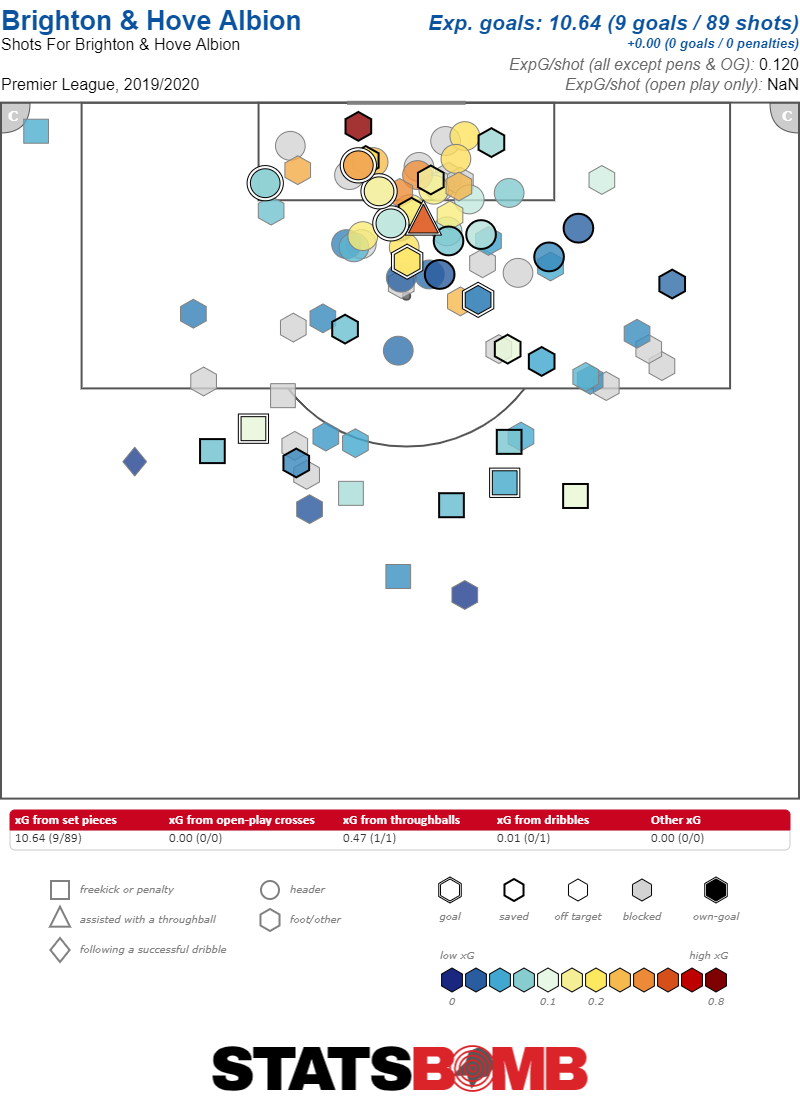We are meant to be witnessing the dawn of a new era for Brighton and Hove Albion. Graham Potter was supposed to be a breath of fresh air that would propel the club up the table after the stodgy stagnation that occurred near the end of Chris Hughton’s reign. Yet with four matches in the book, Brighton find themselves just 16th in the table -- a lone point separating them from the relegation zone they were looking to avoid this season. It’s obviously early days, but looking only at results it would seem like it’s not out of line to paraphrase the Who: Meet the new Brighton, same as the old Brighton. The thing is, Potter’s crew may look like the same old Seagulls bobbing on top of the choppy waters near the relegation waterfall, but underneath the surface, this group is actually paddling like hell toward a safer spot in the table. We just can’t see it without diving in. When taken as a collective, Brighton’s results so far makes it seem, at best, like they’re a lower mid-table club catching a bit of bad luck. It’s certainly better than the dour performances from last year, but it’s the start of a recipe that might lead to a tense relationship with relegation as the season moves along. However, take each match on its own and the signs of a Brighton team ready to ride up the table become much more apparent. In their first match, Brighton produced an xG of 0.82 to Watford’s 0.99, yet won 3-0. Like calling heads five times in a row, this looked to be a lucky case of clinical finishing working in favor of the Seagulls -- this time. Still, as much as we love xG as a predictive and explanatory tool, this match is another lesson in the limitations of blinding following any old formula. 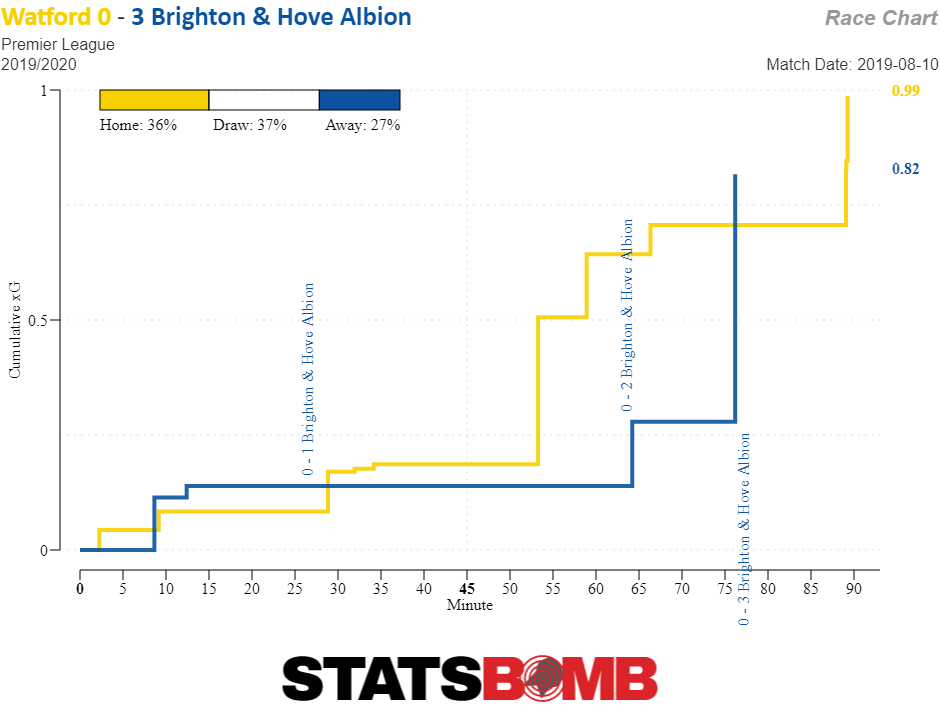 Three things happened that paint a picture of a much more dominant performance by Brighton in this match than the xG totals suggest. The first, obviously, is that, Abdoulaye Doucoure’s own goal -- potentially a high xG chance if he doesn’t redirect the ball himself into Watford’s goal -- isn’t factored into that total. Second is that while Watford’s xG accumulation came largely from peppering Brighton with lower quality chances, the two shots that lead Brighton’s other goals (Florin Andone in the 64th minute and Neal Maupay in the 76th) also happened to be two of the three biggest chances of the match. And third, nine of Watford’s shots came after that Doucoure own-goal where Potter’s flexible three-at-the-back system was more than happy to transition into defend and counter mode. All else (like, specifically xG)being equal, you’d rather be the team creating fewer and better chances than more speculative ones, as research has shown, the team creating the bigger chances will see more points over the long haul even if the overall xG is equal. That’s part of why the next match, a 1-1 draw at home against West Ham, was all the more frustrating for the Seagull supporters. This time Brighton clearly dominated the overall balance of chances (1.81 xG to 0.92) while once again creating golden chances -- a miss by the ageless Glen Murray in the 36th minute just outside of the six yard box and another shot that failed to nestle in the back of the net by Maupay in the 71st (in fairness to West Ham they also created a couple of excellent looks, both Chicharito’s goal on the hour and Michail Antonio’s late stoppage time missed header). Hard not to be happy with the performances after going toe to toe with the opposition on high quality chances while doubling them up in overall xG. Sometimes the shots just don’t fall.
Three things happened that paint a picture of a much more dominant performance by Brighton in this match than the xG totals suggest. The first, obviously, is that, Abdoulaye Doucoure’s own goal -- potentially a high xG chance if he doesn’t redirect the ball himself into Watford’s goal -- isn’t factored into that total. Second is that while Watford’s xG accumulation came largely from peppering Brighton with lower quality chances, the two shots that lead Brighton’s other goals (Florin Andone in the 64th minute and Neal Maupay in the 76th) also happened to be two of the three biggest chances of the match. And third, nine of Watford’s shots came after that Doucoure own-goal where Potter’s flexible three-at-the-back system was more than happy to transition into defend and counter mode. All else (like, specifically xG)being equal, you’d rather be the team creating fewer and better chances than more speculative ones, as research has shown, the team creating the bigger chances will see more points over the long haul even if the overall xG is equal. That’s part of why the next match, a 1-1 draw at home against West Ham, was all the more frustrating for the Seagull supporters. This time Brighton clearly dominated the overall balance of chances (1.81 xG to 0.92) while once again creating golden chances -- a miss by the ageless Glen Murray in the 36th minute just outside of the six yard box and another shot that failed to nestle in the back of the net by Maupay in the 71st (in fairness to West Ham they also created a couple of excellent looks, both Chicharito’s goal on the hour and Michail Antonio’s late stoppage time missed header). Hard not to be happy with the performances after going toe to toe with the opposition on high quality chances while doubling them up in overall xG. Sometimes the shots just don’t fall. 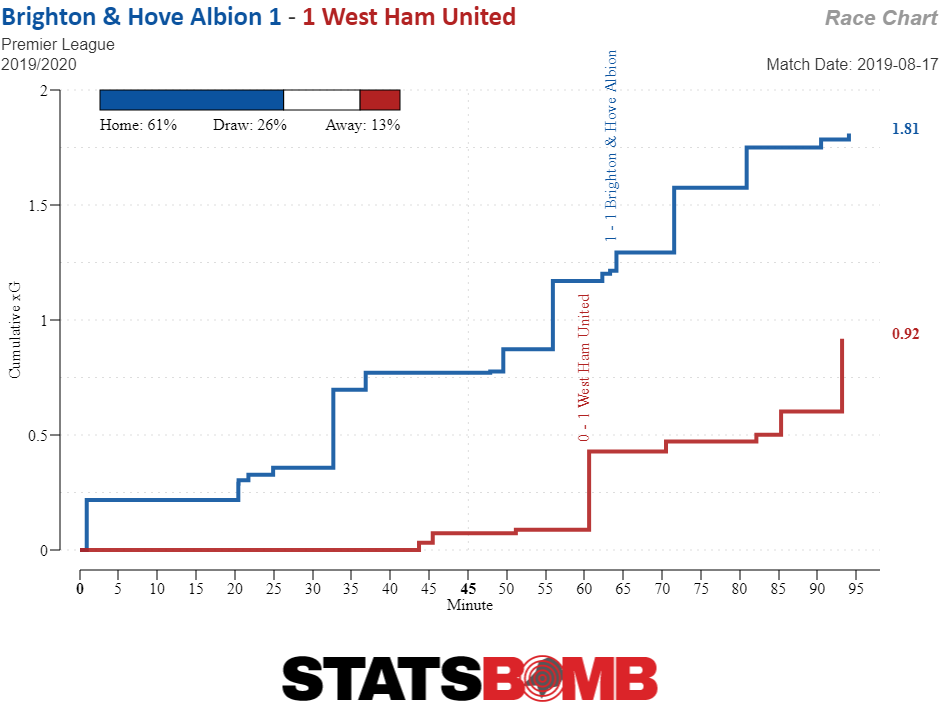 Still, four points from the first two matches isn’t a bad haul for a team looking to break into the top 10. Heading into a home fixture against Southampton,Brighton were in a position to start building that type of early season momentum. Then, in the 29th minute of the match, Andone decided (in likely his last act in a Brighton kit) to do a flying leap into the back of Yan Valey’s leg. A red card followed and the xG tallies from this match -- 1.61 for Southampton to 0.98 for Brighton -- seem in line for a side playing a man down four an hour, right? Well that notion gets a little more complicated when you once again take a closer look. Brighton actually went blow for blow with a Southampton side benefiting from an extra player until the 90th minute. In stoppage time, the Saints created three chances, including Nathan Redmond’s goal, that combined for the vast majority of their overall xG. Given that Brighton was an exhausted group chasing the game with a double pivot of Pascal Groß and Davy Pröpper at that point, it seems like something not reflective of the overall quality of the team’s performance.
Still, four points from the first two matches isn’t a bad haul for a team looking to break into the top 10. Heading into a home fixture against Southampton,Brighton were in a position to start building that type of early season momentum. Then, in the 29th minute of the match, Andone decided (in likely his last act in a Brighton kit) to do a flying leap into the back of Yan Valey’s leg. A red card followed and the xG tallies from this match -- 1.61 for Southampton to 0.98 for Brighton -- seem in line for a side playing a man down four an hour, right? Well that notion gets a little more complicated when you once again take a closer look. Brighton actually went blow for blow with a Southampton side benefiting from an extra player until the 90th minute. In stoppage time, the Saints created three chances, including Nathan Redmond’s goal, that combined for the vast majority of their overall xG. Given that Brighton was an exhausted group chasing the game with a double pivot of Pascal Groß and Davy Pröpper at that point, it seems like something not reflective of the overall quality of the team’s performance. 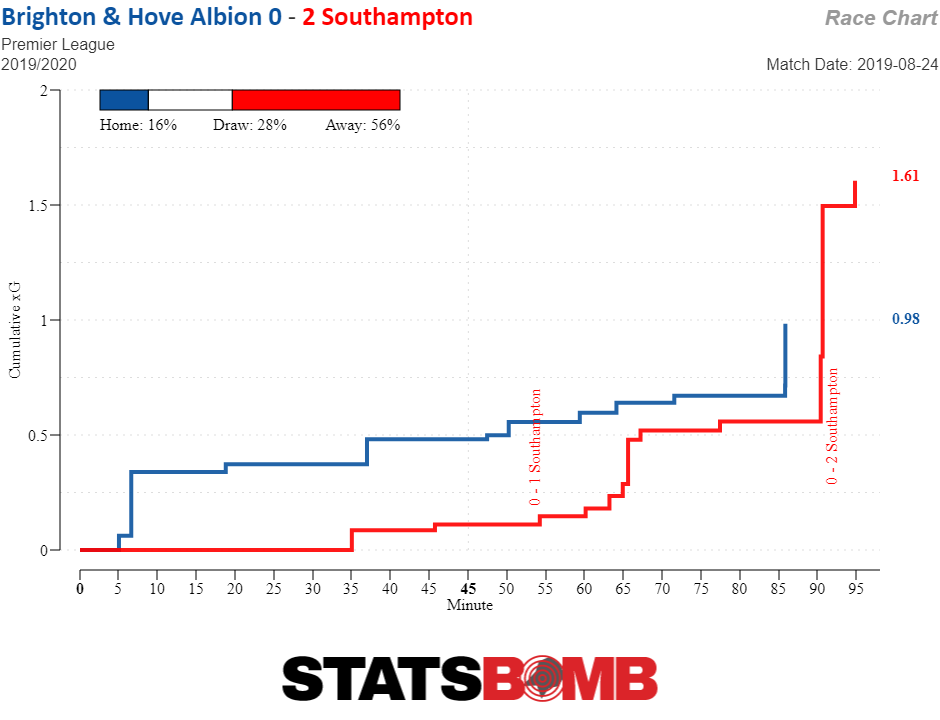 That’s the tricky part about working off four match sample sizes. Over 38 Premier League matches, situations like that will likely reverse themselves and (in theory) restore Brighton’s xG chi. But with just a handful of games being played, the fallout from a red card can wreak serious havoc on club’s performance indicators. So too, by the way, can playing one of the greatest club football teams ever assembled on the road. Any club that comes across Manchester City early in the season, especially at the Etihad, where Pep Guardiola’s side averaged 2.47 non-penatly xG per match while conceding only 0.67, are going to take a blow to their numbers that other outfits that, don’t play the powder blue merchants of soccer death won’t. But Brighton actually fared better than a perennial top six side that visited Manchester just a couple weeks prior. Brighton had a lower xG against (2.20 to Spurs 2.97), a higher xG for (0.51 to 0.19) while producing more shots, more shots on target and completing far more passes in City’s attacking third. Granted, judging teams by how badly they lose to Manchester City isn’t a great barometer, but it certainly raises some eyebrows that Brighton mostly held their own (in a City-weighted way) while Spurs got taken out behind the xG woodshed only to be saved by VAR and some extremely fortunate finishing. After taking these matches one at a time, a very different outlook for Brighton emerges. Luck certainly seems to be playing a factor in Brighton’s middling start. Because of that, it’s obscuring some real progress occurring under Potter’s watch. While Maupay and follow summer transfer window signing Leandro Trossard are certainly boosting the team’s performance, it’s a center back who spent part of last season on loan with Wigan that’s tying things together for Potter: Dan Burn.
That’s the tricky part about working off four match sample sizes. Over 38 Premier League matches, situations like that will likely reverse themselves and (in theory) restore Brighton’s xG chi. But with just a handful of games being played, the fallout from a red card can wreak serious havoc on club’s performance indicators. So too, by the way, can playing one of the greatest club football teams ever assembled on the road. Any club that comes across Manchester City early in the season, especially at the Etihad, where Pep Guardiola’s side averaged 2.47 non-penatly xG per match while conceding only 0.67, are going to take a blow to their numbers that other outfits that, don’t play the powder blue merchants of soccer death won’t. But Brighton actually fared better than a perennial top six side that visited Manchester just a couple weeks prior. Brighton had a lower xG against (2.20 to Spurs 2.97), a higher xG for (0.51 to 0.19) while producing more shots, more shots on target and completing far more passes in City’s attacking third. Granted, judging teams by how badly they lose to Manchester City isn’t a great barometer, but it certainly raises some eyebrows that Brighton mostly held their own (in a City-weighted way) while Spurs got taken out behind the xG woodshed only to be saved by VAR and some extremely fortunate finishing. After taking these matches one at a time, a very different outlook for Brighton emerges. Luck certainly seems to be playing a factor in Brighton’s middling start. Because of that, it’s obscuring some real progress occurring under Potter’s watch. While Maupay and follow summer transfer window signing Leandro Trossard are certainly boosting the team’s performance, it’s a center back who spent part of last season on loan with Wigan that’s tying things together for Potter: Dan Burn. 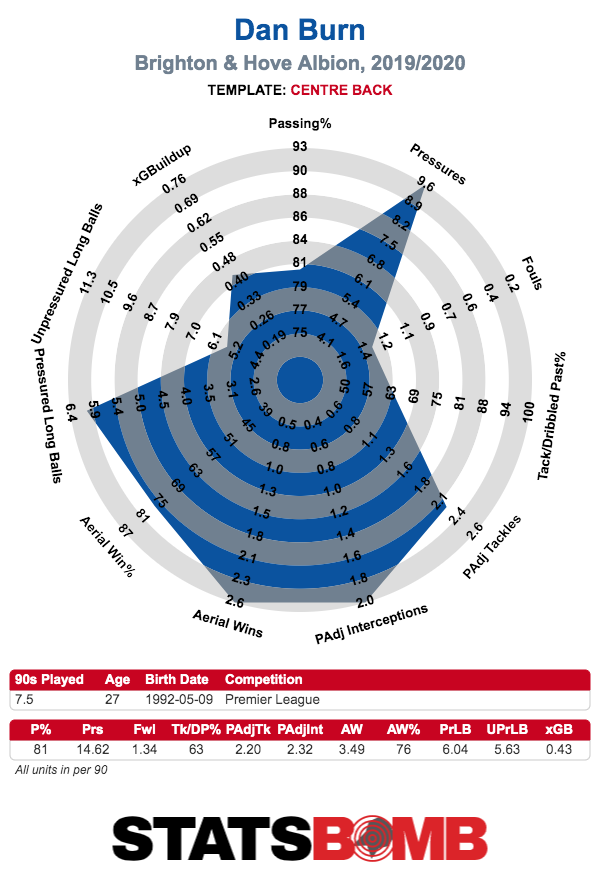 For clubs without the financial might of a PSG, Real Madrid or Manchester City, finding a system with a balance between attack and defense is a near impossible task. Pour too many bodies forward in search of goals and opponents destroy you on the counter. Hold too many back and the opposition keeper hardly gets put to the test. Burn, amazingly, has been Potter’s answer to a conundrum faced by mid table clubs around the globe. Operating as the nominal left-sided center back, Burn gives the Brighton a third defender near the box when they don’t have the ball -- a helpful concept for a team currently ranked ninth in the Premier League when it comes to passes played per match. The problem most teams have with such a setup is that when they do have the ball, those extra center backs offer little in the way of attacking support (see: Wolves, Wolverhampton). But Potter’s directions for Burn are quite different. In possession, Burn often combines with Solly March, Brighton’s left wing back. This allows March, a converted midfielder, to have a player to combine with while moving the ball up the field. Here are all the completed passes between the two over the first four matches.
For clubs without the financial might of a PSG, Real Madrid or Manchester City, finding a system with a balance between attack and defense is a near impossible task. Pour too many bodies forward in search of goals and opponents destroy you on the counter. Hold too many back and the opposition keeper hardly gets put to the test. Burn, amazingly, has been Potter’s answer to a conundrum faced by mid table clubs around the globe. Operating as the nominal left-sided center back, Burn gives the Brighton a third defender near the box when they don’t have the ball -- a helpful concept for a team currently ranked ninth in the Premier League when it comes to passes played per match. The problem most teams have with such a setup is that when they do have the ball, those extra center backs offer little in the way of attacking support (see: Wolves, Wolverhampton). But Potter’s directions for Burn are quite different. In possession, Burn often combines with Solly March, Brighton’s left wing back. This allows March, a converted midfielder, to have a player to combine with while moving the ball up the field. Here are all the completed passes between the two over the first four matches. 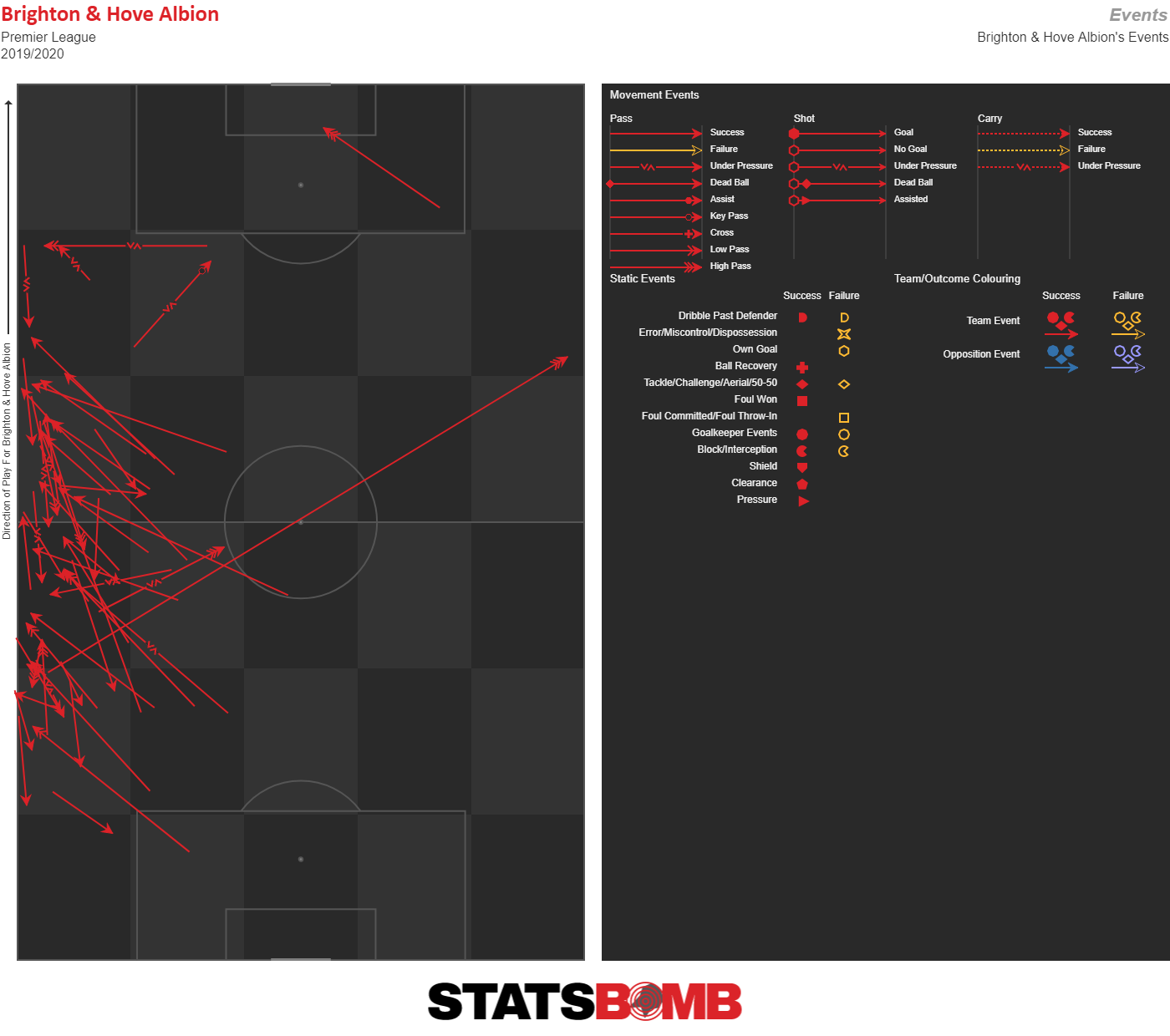 Burn even covers March’s movement by providing the width on the left flank and, occasionally, making an overlapping run to fire in a cross (Burn has three from open play this season). Here are all Burn's passes this season so far.
Burn even covers March’s movement by providing the width on the left flank and, occasionally, making an overlapping run to fire in a cross (Burn has three from open play this season). Here are all Burn's passes this season so far. 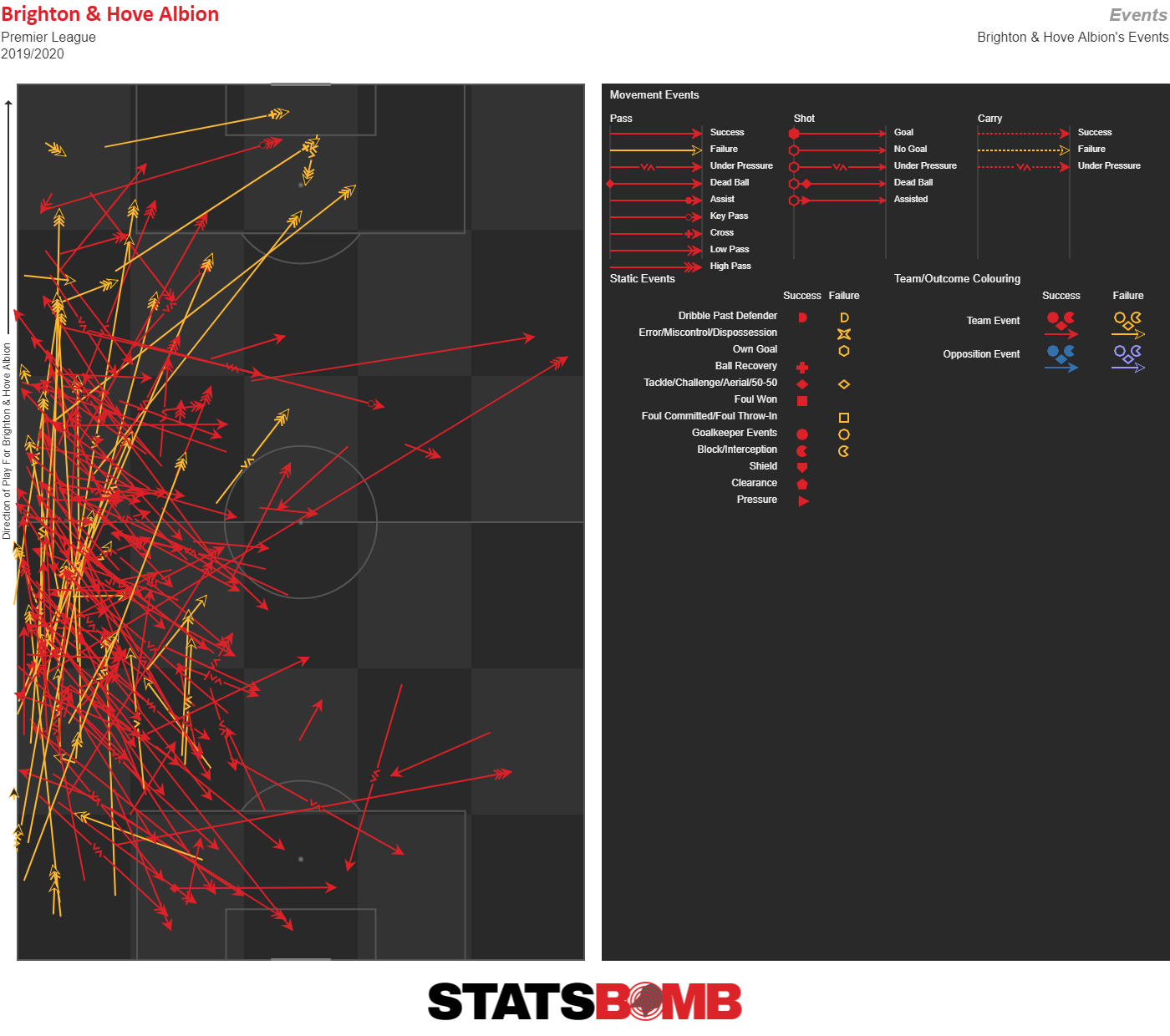 Burn’s tactical flexibility is part of why Brighton has been able to boost their attacking numbers -- the Seagulls are 13th in xG this year, which may not seem like much, but it's a step forward after finishing second-to-last in Hughton’s final season -- while not compromising their defense too much. Brighton currently sits in 15th place in xGA, which is five spots lower than last season, but taking into account playing a man down for 60 minutes against Southampton and playing 90 minutes against the wrecking ball that is Manchester City, it's still quite promising. So, when it comes to Brighton’s fortunes, don’t go throwing on The Who just yet. This doesn’t seem to be the same old Brighton. And that’s thanks in large part to their new boss.
Burn’s tactical flexibility is part of why Brighton has been able to boost their attacking numbers -- the Seagulls are 13th in xG this year, which may not seem like much, but it's a step forward after finishing second-to-last in Hughton’s final season -- while not compromising their defense too much. Brighton currently sits in 15th place in xGA, which is five spots lower than last season, but taking into account playing a man down for 60 minutes against Southampton and playing 90 minutes against the wrecking ball that is Manchester City, it's still quite promising. So, when it comes to Brighton’s fortunes, don’t go throwing on The Who just yet. This doesn’t seem to be the same old Brighton. And that’s thanks in large part to their new boss.
2019
The case for Brighton
By admin
|
September 10, 2019
